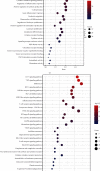Real-World Study on Chai-Shi-Jie-Du Granules for the Treatment of Dengue Fever and the Possible Mechanisms Based on Network Pharmacology
- PMID: 37680700
- PMCID: PMC10482559
- DOI: 10.1155/2023/9942842
Real-World Study on Chai-Shi-Jie-Du Granules for the Treatment of Dengue Fever and the Possible Mechanisms Based on Network Pharmacology
Abstract
Objectives: Traditional Chinese medicine (TCM) is a widely used method for treating dengue fever in China. TCM improves the symptoms of patients with dengue, but there is no standard TCM prescription for dengue fever. This real-world study aimed to evaluate the effects of Chai-Shi-Jie-Du (CSJD) granules for the treatment of dengue fever and the underlying mechanisms.
Methods: We implemented a multicenter real-world study, an in vitro assay and network pharmacology analysis. Patients from 5 hospitals in mainland China who received supportive western treatment in the absence or presence of CSJD were assigned to the control and CSJD groups between 1 August and 31 December 2019. Propensity score matching (PSM) was performed to correct for biases between groups. The clinical data were compared and analyzed. The antidengue virus activity of CSJD was tested in Syrian baby hamster kidney (BHK) cells using the DENV2-NGC strain. Network pharmacological approaches along with active compound screening, target prediction, and GO and KEGG enrichment analyses were used to explore the underlying molecular mechanisms.
Results: 137 pairs of patients were successfully matched according to age, sex, and the time from onset to presentation. The time to defervescence (1.7 days vs. 2.5 days, P < 0.05) and the disease course (4.1 days vs. 6.1 days, P < 0.05) were significantly shorter in the CSJD group than those in the control group. CSJD showed no anti-DENV2-NGC virus activity in BHK cells. Network pharmacology analysis revealed 108 potential therapeutic targets, and the top GO and KEGG terms were related to immunity, oxidative stress response, and the response to lipopolysaccharide.
Conclusions: CSJD granules exhibit high potential for the treatment of dengue fever, and the therapeutic mechanisms involved could be related to regulating immunity, moderating the oxidative stress response, and the response to lipopolysaccharide.
Copyright © 2023 Huiqin Yang et al.
Conflict of interest statement
The authors declare that they have no conflicts of interest.
Figures





Similar articles
-
Molecular mechanism of ChaiShi JieDu granule in treating dengue based on network pharmacology and molecular docking: A review.Medicine (Baltimore). 2023 Dec 29;102(52):e36773. doi: 10.1097/MD.0000000000036773. Medicine (Baltimore). 2023. PMID: 38206728 Free PMC article. Review.
-
Effects of Chinese and Western Medicine on Patients with Dengue Fever.Am J Chin Med. 2020;48(2):329-340. doi: 10.1142/S0192415X20500160. Epub 2020 Mar 5. Am J Chin Med. 2020. PMID: 32138530
-
He-Jie-Shen-Shi Decoction as an Adjuvant Therapy on Severe Coronavirus Disease 2019: A Retrospective Cohort and Potential Mechanistic Study.Front Pharmacol. 2021 Jun 18;12:700498. doi: 10.3389/fphar.2021.700498. eCollection 2021. Front Pharmacol. 2021. PMID: 34220524 Free PMC article.
-
Exploring the Potential Targets and Mechanisms of Huang Lian Jie Du Decoction in the Treatment of Coronavirus Disease 2019 Based on Network Pharmacology.Int J Gen Med. 2021 Dec 16;14:9873-9885. doi: 10.2147/IJGM.S337025. eCollection 2021. Int J Gen Med. 2021. PMID: 34938107 Free PMC article.
-
Exploration of the mechanism of Zisheng Shenqi decoction against gout arthritis using network pharmacology.Comput Biol Chem. 2021 Feb;90:107358. doi: 10.1016/j.compbiolchem.2020.107358. Epub 2020 Aug 8. Comput Biol Chem. 2021. PMID: 33243703 Review.
References
-
- Dengue. Guidelines for Diagnosis, Treatment, Prevention and Control . Geneva, Switzerland: World Health Organization; 2009. - PubMed
LinkOut - more resources
Full Text Sources
Miscellaneous

